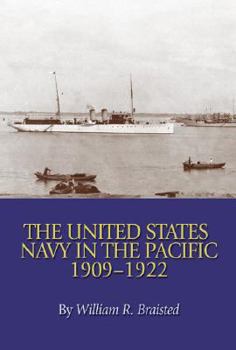The United States Navy in the Pacific, 1909-1922
(Book #2 in the The United States Navy in the Pacific Series)
Select Format
Select Condition 
Book Overview
In this continuation of his study of the interrelationship of naval and diplomatic policies, Braisted picks up the story in 1909 with the inauguration of President Taft and ends with the Washington Arms Conference of 1921-1922. He pays close attention to the efforts of U.S. naval leaders to secure the East Asian possessions of the United States against possible Japanese attack by assuring the Navy's capacity to win and retain control of the western...
Format:Paperback
Language:English
ISBN:1591140889
ISBN13:9781591140887
Release Date:April 2008
Publisher:US Naval Institute Press
Length:760 Pages
Weight:2.30 lbs.
Dimensions:1.9" x 6.0" x 9.0"
Customer Reviews
2 ratings
Pacific Strategies
Published by Thriftbooks.com User , 15 years ago
This book provides an excellent account of the strategies developed by the newly modernized U.S. Navy to deal with its responsibilities in the Pacific. When the U.S. acquired both Guam and the Philippines at the end of the Spanish-American War (1898) as colonial possessions, it also acquired the responsibility to defend them. After the Boxer rebellion (1900) the U.S. formulated a foreign policy designed to protect China's sovereignty and free trade with China by all nations. All this was complicated by the emergence of Japan as a major naval power and the political upheaval in China that finally deposed the last imperial dynasty, but also left China in chaos. It quickly became apparent that Japan was major threat to U.S. policy towards China, U.S. possessions in the Eastern Pacific, and, according to some, the entire U.S. West Coast. As this book makes clear it is fair to say that it was in this period the U.S. Navy's strategies in the Pacific were directed towards thwarting Japanese efforts to establish de facto control over the China and the Western Pacific, including confronting and defeating the Imperial Japanese Navy. This is a theme throughout this book. The U.S. Navy however faced two major obstacles in developing effective Pacific strategies. The first was the conundrum created by adherence to the strategic dictate of the brilliant naval theorist Alfred Thayer Mahan who held that the integrity of the main battle fleet of the U.S. should always be maintained and that the proper station for this fleet was the Atlantic not Pacific Ocean. This conundrum was only partially solved by the opening of the Panama Canal because of the time it would take the entire U.S. battle fleet to move from the Atlantic to the Pacific even with the canal. The second obstacle was that the navy had only one suitable shore installation on the West Coast located in Puget Sound Washington and one les than adequate one at Mare Island in San Francisco. To remedy this, the U.S. Navy embarked on a spasmodic base building program to create suitable shore facilities (e.g. battleship size dry-docks, ammunition and fuel storage) at Puget Sound, San Francisco, and San Diego. Most importantly the Navy sought to build a major base on Oahu Hawaii and the U.S. Army agreed to fortify this island. The Navy had rather less luck in the Eastern Pacific and in the end fortified well garrisoned naval bases were never established in either Guam or the Philippines. This is good read that explains a good deal of the origins of U.S. military and diplomatic policy between the wars.
Lots of important, but too often ignored History
Published by Thriftbooks.com User , 15 years ago
The involvement of the US Navy in the affairs of the Western Pacific are revealed in these books in a vividly interesting manner. Lots of important things that are not commonly knows are revealed here. For instance an absolutely astonishing revelation and riveting account of how we and a dozen allied nations ended up running the Trans-Siberian Railroad while Russia was still trying to fight Germany during WW-I.





